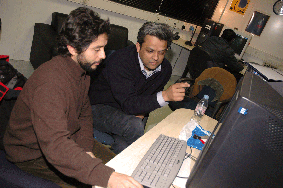- Home
- News
- General News
- PRESS RELEASE: A...
PRESS RELEASE: A key that opens cells to the deadly malaria parasite
19-12-2005
Researchers at the International Centre for Genetic Engineering and Biotechnology (ICGEB) in India and a unit of the European Molecular Biology Laboratory (EMBL) in France have made a key discovery about a molecule that helps the malaria parasite infect human cells. India is one of the countries most affected by this disease, which has infected 300 million people across the world and leads to over one million fatalities per year. The breakthrough, which was achieved at the European Synchrotron Radiation Facility (ESRF) in Grenoble, may represent an important step towards finding new therapies. The study appears in this week’s online edition of Nature (December 21).
 |
 |
ESRF-EMBL JOINT PRESS RELEASE
 |
"Good targets for drugs": Hassan Belrahli (left) discusses with Amit Sharma (right) in the control cabin of the beamline BM14. |
Malaria is caused by a one-celled organism called Plasmodium, which is passed to humans through the bite of Anopheles mosquitoes. The parasite replicates inside red blood cells, which eventually burst. In order to enter these cells, it first has to bind to the cell through interactions of proteins on the surfaces of red blood cells and the parasite.
The new study reveals key features of a protein on the surface of Plasmodium that permits it to bind. The researchers obtained crystals of a module of this protein, called the Duffy-Binding Like (DBL) domain, which directly interacts with a "receptor" protein on red blood cells. Then they examined the crystals using very powerful X-rays of the UK-Medical Research Council Beamline BM14 at the European Synchrotron Radiation Facility (ESRF) in Grenoble. X-ray crystallography is one of the only methods available to create atom-by-atom maps of proteins, which are too small to be seen by microscopes.
"Until now we have not had a close-up view of the precise surface where the two proteins interact," explains Amit Sharma, the corresponding author of the paper. "That surface is absolutely crucial in permitting the parasite to enter the cell. If we can determine its features in atomic detail, we may be able to find weak points that could make good targets for drugs."
In addition to interfering with the binding process, such drugs would also have to be specific: in other words, they shouldn't interfere with normal processes in red blood cells. The receptor protein that allows Plasmodium to enter undoubtedly has other important functions. "What we've found is that the DBL has an absolutely unique architecture, which means that there should be a way to inhibit its activity without affecting healthy blood cells," says Hassan Belrhali, an EMBL researcher who participated in the project.
Evolution has produced many different species of Plasmodium. This work was carried out using a form of the parasite that doesn't normally infect humans, but DBL modules are similar in different forms of the organism. This makes it likely that the findings can be extended to other types of Plasmodium. “Our results provide a structural framework by which to understand the DBLs of most malaria parasites, and could have an impact in the design of drugs to fight against this illness,” explains Amit Sharma.
The researchers are also investigating molecules important at an earlier phase of malaria infections, when parasites invade the liver.
Reference: S.K. Singh, R. Hora, H. Belrhali, C.E. Chitnis & A. Sharma. Structural basis for Duffy recognition by malaria parasite Duffy-binding-like domain. Nature, online publication December 21, 2005.



